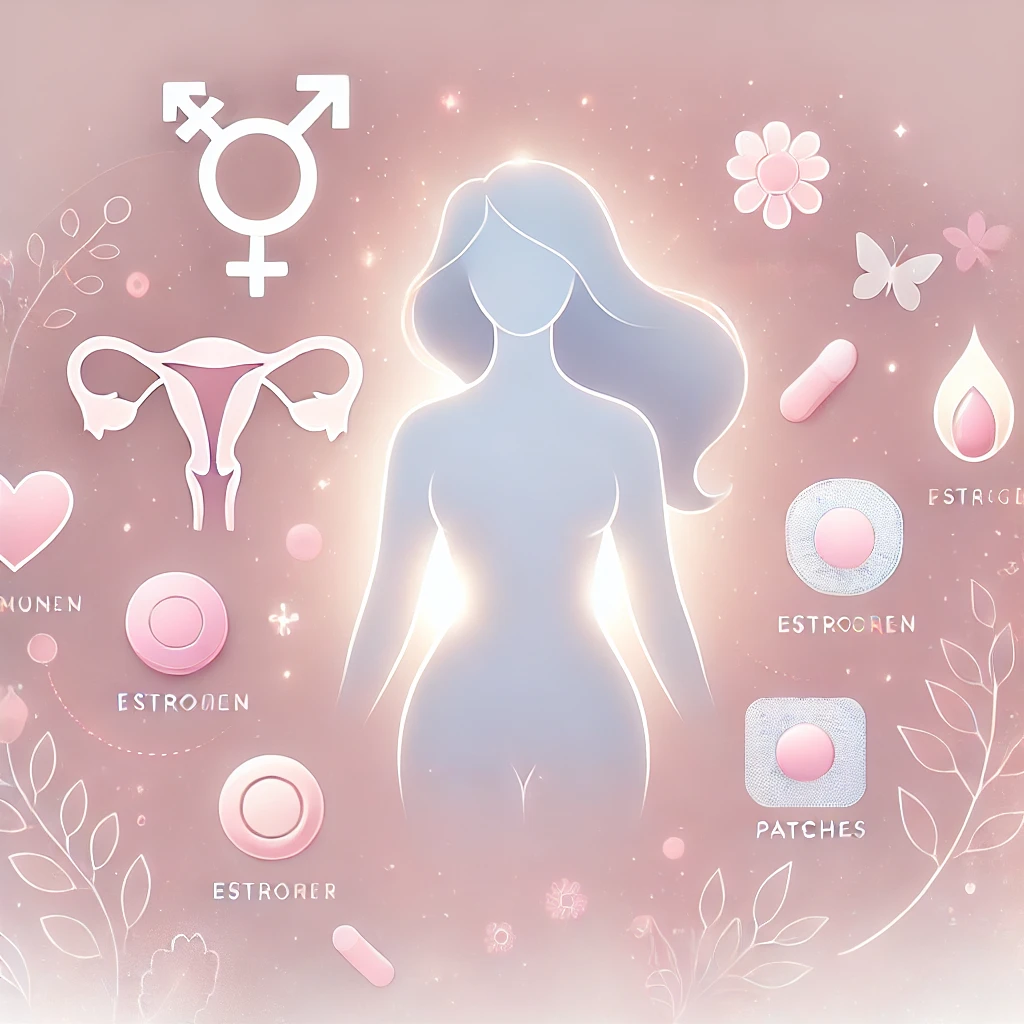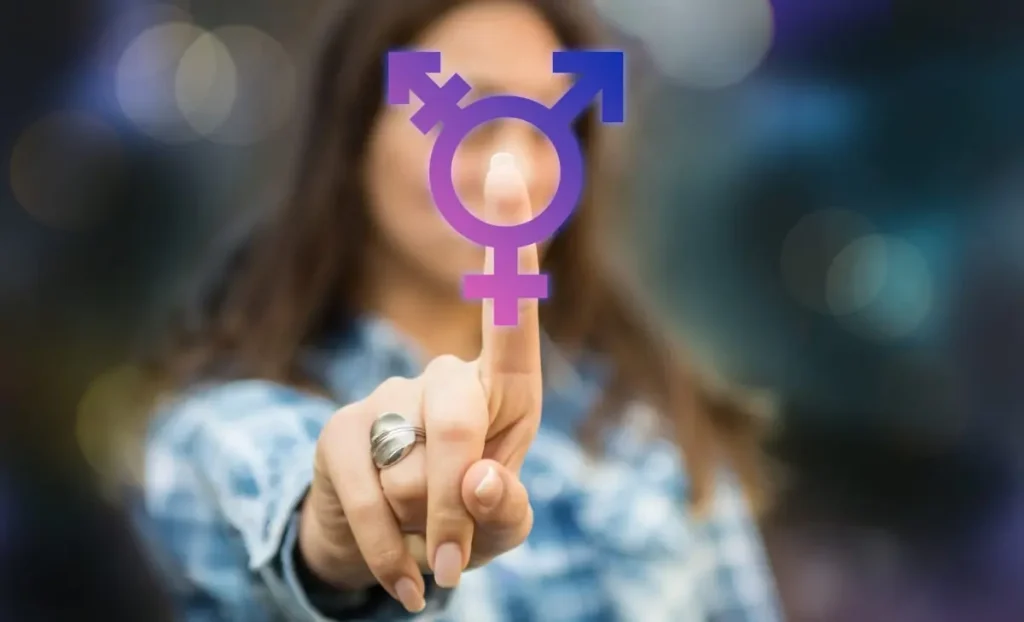Welcome to the Introduction to Feminizing Hormone Therapy! This blog will guide you through how hormone therapy can help you feel more feminine, both in body and mind.
It’s an important step in your journey, and understanding how it works is essential.
So, read on to discover how these changes can help you express your true self. Don’t forget to share your thoughts in the comments and let us know what you think!
What is Feminizing Hormone Therapy?
Feminizing hormone therapy, also known as gender-affirming hormone therapy, is a medical treatment that helps transgender women, non-binary, and gender-nonconforming individuals develop physical traits that are typically associated with a feminine body.
It involves the use of two key hormones: estrogen and anti-androgens.

- Estrogen: This is the hormone primarily responsible for developing secondary female sex characteristics. By increasing estrogen levels in your body, you can expect changes such as breast growth, softer skin, and a more traditionally feminine distribution of body fat (think curvier hips and thighs)(Cleveland Clinic).
- Anti-Androgens: These medications work to reduce the production or effects of testosterone, the hormone responsible for masculine traits like facial hair and muscle mass. By lowering testosterone levels, anti-androgens help to minimize masculine features and make estrogen more effective in promoting femininity(Fenway Health).
Who Benefits from Feminizing Hormone Therapy?
FHT is commonly used by individuals who wish to transition to a more feminine appearance and feel more aligned with their gender identity. This therapy is particularly beneficial for:
- Transgender Women: Those assigned male at birth but who identify as female can use FHT to develop feminine traits such as breast growth, reduced body hair, and softer facial features. These changes help them feel more comfortable in their own skin and experience less gender dysphoria.
- Non-Binary Individuals: Some people who identify as non-binary, meaning their gender identity doesn’t fit into the traditional categories of male or female, may seek hormone therapy to soften masculine features and create a more androgynous or feminine appearance.
- Gender Non-Conforming People: FHT is also an option for individuals who don’t strictly identify as male or female but prefer a more feminine physical presentation. It’s all about helping you feel like the most authentic version of yourself!

1. Understanding How Feminizing Hormone Therapy Works
Estrogen and Anti-Androgens: The Dynamic Duo
Feminizing hormone therapy primarily uses two types of hormones: estrogen and anti-androgens. These work together like a magical beauty team, helping your body shift from masculine traits to more feminine ones.
- Estrogen: This is the star of the show! Estrogen promotes feminine characteristics by triggering changes in your body, like breast development and redistribution of body fat to areas like the hips, thighs, and buttocks. Over time, your skin may become softer and smoother, giving it that lovely, glowy appearance that many desire.
- Anti-Androgens: While estrogen is busy doing its thing, anti-androgens are working behind the scenes to reduce the effects of testosterone, the hormone responsible for more masculine traits. These meds block or lower testosterone production, leading to things like slowed facial hair growth, reduced body hair, and a decrease in muscle mass. Together, estrogen and anti-androgens help create a softer, more feminine look by balancing out your hormone levels.
It’s important to note that while estrogen helps with many feminine changes, it won’t affect your voice—that’s where vocal training or surgery might come into play. But the combination of these hormones can work wonders when it comes to reshaping your body’s overall appearance!
Physical Changes to Expect
Now, let’s talk about what kinds of changes you might notice with feminizing hormone therapy. These changes don’t happen overnight—they take time, patience, and a little bit of self-love along the way.
- Softer Skin: One of the first things you’ll likely notice is your skin becoming softer and less oily. This is one of those lovely changes that gives you a more radiant, feminine glow.
- Breast Growth: With estrogen on board, you can expect some breast development to begin within the first few months. The extent of breast growth varies from person to person, but many start to notice growth around 3–6 months into therapy. Just like puberty, though, full development can take up to two years.
- Fat Redistribution: Over time, you’ll also start to see a shift in how your body stores fat. You’ll likely notice more fat accumulating in the hips, thighs, and buttocks, giving you that curvier, more feminine shape. At the same time, fat distribution in your abdomen and upper body may decrease, further softening your overall figure.
- Reduced Muscle Mass: Anti-androgens will help reduce muscle mass, especially in areas like your arms and shoulders, which tend to be more masculine. This gives you a softer, less bulky look as your muscles become less defined.
- Body and Facial Hair: Over time, you may notice that body hair becomes thinner, softer, and grows more slowly. However, it’s important to know that while feminizing hormone therapy can help reduce hair growth, it doesn’t always completely eliminate facial hair. Additional hair removal methods, like laser treatments, may be needed for a fully smooth face.
Everyone’s body is different, so these changes can vary from person to person. Some might see changes quickly, while others need more time. Typically, the most noticeable changes start within the first 3–6 months, but full effects can take up to 18–24 months. Don’t worry if things take a little longer—your body is working hard to transform, and it’s all part of your unique journey!
2. Preparing for Feminizing Hormone Therapy
Mental Health Considerations
Before starting feminizing hormone therapy (FHT), a mental health evaluation is an essential step in the process. This isn’t just a formality—it’s meant to ensure that you’re mentally and emotionally ready for the changes that come with transitioning.
For many people, the process is exciting but also comes with emotional adjustments, so it’s crucial to be prepared.The main focus during the mental health evaluation is diagnosing gender dysphoria. This diagnosis is important because it helps confirm that FHT aligns with your goals for gender affirmation.
Gender dysphoria refers to the discomfort or distress caused by a mismatch between your gender identity and your assigned sex at birth.
A licensed mental health professional will typically assess this during a meeting where they’ll ask questions about your experience with gender, your feelings toward your body, and how those feelings have impacted your life.

But that’s not all! They’ll also look at any other mental health issues you might be dealing with, like anxiety or depression. If you’re struggling with these, don’t worry—it doesn’t mean you can’t start FHT.
It just means your healthcare team will want to make sure these conditions are well managed before moving forward. Transitioning can be both exciting and emotional, so having strong mental health support can really help you along the way.
The mental health evaluation isn’t just about ticking boxes. It’s about making sure that you have all the resources you need to feel safe, supported, and prepared for the emotional and physical changes FHT brings. And remember, you’re not alone in this process—your mental health provider will be there for you, ready to help at every step!
Medical Evaluations 🩺
Once you’re emotionally ready, the next step is making sure your body is prepared for hormone therapy. This involves several medical evaluations, which include physical exams and lab tests. These screenings are crucial for identifying any underlying health conditions that could impact your hormone therapy or be made worse by it.
Your healthcare provider will run blood tests to check key markers of your overall health. This includes monitoring your cholesterol levels, blood pressure, and liver function, as FHT can sometimes affect these areas.
Estrogen, for example, can increase your risk for blood clots, which is why your doctor will keep a close eye on your cardiovascular health. If you have a history of heart disease or blood clotting disorders, your healthcare provider may take extra precautions or adjust your treatment plan.
They’ll also look at things like your triglyceride levels (a type of fat in your blood), which can rise during hormone therapy, and check for conditions like diabetes, which may need to be managed more carefully once you start FHT.
3. Timeline of Changes and What to Expect
Short-Term vs Long-Term Effects
Starting feminizing hormone therapy (FHT) is such an exciting step, but it’s important to know that changes won’t happen overnight. Every body is unique, so results can vary, but here’s a general timeline of what you can expect on your beautiful journey.
Short-Term Changes (3-6 months)
In the first few months of hormone therapy, subtle yet lovely transformations will begin. These are some of the first signs that your body is responding to FHT:
- Softer Skin: Within the first 3-6 months, you’ll likely notice your skin becoming softer and smoother. Estrogen reduces oil production, which means your skin may feel less oily and more delicate to the touch.
- Decreased Muscle Mass: If you’ve been concerned about a more muscular or “masculine” build, FHT works to soften this by reducing muscle mass. This process takes a few months, but over time, your body will naturally start to look less bulky and more feminine.
- Body Fat Redistribution: Over time, your body will begin redistributing fat, especially around your hips, thighs, and buttocks, giving you a curvier silhouette. This usually starts around the 3 to 6-month mark but continues to develop with time.
Long-Term Changes (6 months to 2 years)
As you continue on your hormone journey, the effects become more pronounced and impactful. Here’s what you can expect as time passes:
- Breast Development: One of the most anticipated changes is breast growth, which usually begins within the first 6 to 12 months of FHT. While everyone’s results vary, the process typically takes around 2 years for full development. Don’t worry if things seem slow—breasts grow at their own pace, and patience is key.
- Facial Hair Reduction: Another exciting change is the reduction of facial and body hair. Anti-androgens help slow down hair growth, and over time, you’ll notice your facial hair becoming thinner and growing more slowly. Full results may take 1-2 years, but pairing FHT with hair removal treatments like laser or electrolysis can speed things along.
- Body Shape: After about 6 months, your body will continue adjusting to its new shape as fat redistributes, giving you more curves. This process usually completes after 1 to 2 years, as estrogen continues to work its magic on your hips and thighs.
Emotional and Psychological Impact
The emotional journey of transitioning can be just as profound as the physical one. Seeing your body change to match your true self can bring an overwhelming sense of joy and relief. Many people report feeling more at ease, confident, and happy in their skin as these changes unfold.
However, it’s important to manage expectations. The pace of change can be slow at times, and that might cause some frustration. Remember, lovely—patience is everything! Your body is adjusting and evolving.
While it may take up to two years to see the full effects of FHT, every step along the way is part of your beautiful transformation. Be kind to yourself during this time and celebrate each milestone, no matter how small.
Hormone therapy can also have positive effects on mental health, helping to reduce symptoms of gender dysphoria and improving overall well-being. For many, it feels like finally coming home to themselves.
4. Risks and Side Effects of Feminizing Hormone Therapy
Feminizing hormone therapy (FHT) can be a beautiful and transformative experience, but it’s super important to understand that there are some risks involved. Let’s talk about the common side effects and why working closely with your healthcare provider is essential to keep you safe and healthy.
Potential Side Effects
1. Increased Risk of Blood Clots One of the more serious risks of FHT is the potential for developing blood clots, also known as venous thromboembolism (VTE). This can happen because estrogen, a key hormone in FHT, can increase the likelihood of clots forming in your veins.
These clots may lead to more severe issues, like deep vein thrombosis (DVT) or pulmonary embolism, which is when a clot travels to your lungs. To reduce this risk, your healthcare provider will carefully monitor your hormone levels and may recommend regular blood tests to ensure everything is in balance.
2. Weight Gain FHT can cause weight gain, which is a fairly common side effect. This happens because estrogen influences how your body stores fat, often leading to increased fat in areas like your hips, thighs, and breasts.
While these changes may help you feel more feminine, they can also lead to overall weight gain. Maintaining a healthy lifestyle with a balanced diet and regular exercise can help manage this, but your doctor will also keep an eye on any significant changes.
3. Reduced Fertility A very important consideration before starting FHT is the effect on fertility. Over time, hormone therapy can reduce or even eliminate the ability to produce sperm. This means it could lead to permanent infertility.
For anyone who thinks they might want biological children in the future, it’s crucial to think about options like sperm banking before beginning therapy. Sperm banking allows you to store sperm in case you want to have children later, even after starting hormones.
4. Other Possible Side Effects In addition to the major risks, there are other side effects you might experience, including:
- Breast tenderness and development: While this is often a desired effect, it can come with some discomfort.
- Mood changes: Hormones can affect your mood, leading to emotional shifts.
- Lowered libido: Many people notice a decrease in their sex drive due to testosterone suppression.
Why It’s Important to Work with Your Healthcare Provider 🩺
Your healthcare provider is going to be your BFF during this process. Regular monitoring is super important to make sure the hormones are doing what they’re supposed to, without putting your health at risk.
They’ll check your hormone levels, look out for signs of blood clots, and help manage any side effects like weight gain or mood changes. Open communication with your healthcare team will help you feel empowered and supported throughout your journey.
5. What You Need to Know About Maintenance and Monitoring
Routine Monitoring
Once you’ve started feminizing hormone therapy (FHT), keeping up with regular checkups is super important! Your healthcare team will be your besties in this journey, making sure everything is going smoothly.
Regular monitoring isn’t just about tracking your progress; it’s also crucial to ensure that your hormone levels are balanced, and any side effects are managed.
Your doctor will typically run blood tests every 3 to 6 months in the first year, then less frequently once things have stabilized. They’ll monitor your hormone levels—like estrogen and testosterone—to ensure you’re getting just the right dose.
If your levels are too high or too low, your body might not respond the way you want, or you could face unwanted side effects like mood swings, blood clots, or liver issues.
During these visits, they’ll also check for changes in your physical health—such as breast growth, skin softening, and fat redistribution. It’s a good time to bring up anything you’ve noticed, like skin changes, energy levels, or changes in sexual health.
Plus, staying on top of your health can help spot any risks early, like blood clots or changes in cholesterol levels, which some people on hormone therapy can experience.
These appointments are also great for mental health check-ins! Hormone therapy can be a big emotional rollercoaster, so your provider can help connect you with the right resources if you’re feeling overwhelmed.
Lifelong Commitment
Feminizing hormone therapy isn’t a one-and-done thing. For most people, it’s a lifelong commitment. That might sound like a lot, but don’t worry—it’s all about maintaining the beautiful changes you’ve worked so hard for! Over time, your doctor might adjust the dosage of your hormones as your body stabilizes.
But even once you’ve reached your desired feminine appearance, you’ll likely need to continue taking a maintenance dose of estrogen and anti-androgens to keep your body’s natural testosterone from undoing the changes.
Skipping regular doses or stopping therapy can reverse some of the effects, such as muscle mass returning or body hair growing back, so it’s essential to stay consistent. Plus, staying on hormones long-term helps support your bone health and keeps your cardiovascular system happy by managing any risks like high cholesterol.
Remember, FHT is a personal journey, and everyone’s body reacts differently. Some people might need more adjustments along the way, and that’s totally okay! Keep an open dialogue with your healthcare provider to make sure you’re always feeling your best.
6. Emotional and Social Considerations

Support Systems
Going through any kind of transition can be an emotional rollercoaster, and it’s super important to have people by your side who understand and support you. Whether it’s your friends, family, or LGBTQ+ communities, having a support system can make all the difference.
Reaching out to those who are already in your life, or connecting with groups where people are going through similar experiences, can help you feel less alone.
Online platforms, like those offered by the Trevor Project or Human Rights Campaign, provide safe spaces where you can chat with others or find resources tailored to your needs.
Many LGBTQ+ individuals have faced isolation or rejection, which can lead to anxiety or depression, so having a support network is key to maintaining your emotional well-being.
Body Image and Expectations
Everyone’s transition journey is unique, and it’s important to manage expectations. The media often paints an unrealistic picture of how people “should” look or feel during and after transitioning.
This can sometimes create pressure and impact your body image. Remember, transitioning is a personal process, and comparing yourself to others isn’t fair to you.
It’s also crucial to accept that changes can take time, whether they’re physical or emotional. Some days may be harder than others, but accepting yourself at every stage is empowering.
Positive reinforcement, from both yourself and those around you, can help keep your confidence up. Embrace the fact that there’s no “right way” to transition, and focus on what makes you feel the most comfortable in your own skin.
Conclusion
Feminizing hormone therapy is a powerful step for anyone looking to embrace their true feminine self. It helps transform both the body and mind, bringing you closer to the person you truly want to be.
While the journey can be exciting, it’s important to be informed about the changes, challenges, and the long-term effects that come with it.
Always consult a healthcare professional to make sure it’s the right path for you, and remember, every step you take is part of your beautiful transformation. Embrace it with patience and self-love!
Don’t forget to share your thoughts in the comments and spread this information to help others on their own journey!
Also Read: How to Walk Gracefully in Heels


